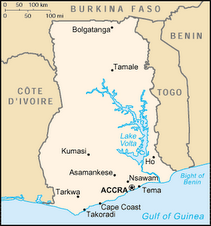Last week, with my wife, Cyndy, in attendance I had the honor of being inducted into the Ghana College of Physicians and Surgeons. The following night she flew home for Christmas with the children and I went to pilot an ultra light plane, but was grounded due to visibility. While waiting for better visibility, I toured the Akosombo Dam, which supplies seventy-five percent of Ghana’s electricity. Before the weather improved, I had to return to Tamale. It was a nice break.
When going to Church, I was picked up by a small taxi which already had eight occupants. I hesitated to get in, but joined the crowd. When requesting a stop, the driver questioned if I was not going to the hospital. This explains why he picked me up with a full cab. He was doing his part to help me get to the hospital.
The following photos are of an infant who swallowed a hair clip, an elderly man with a left facial paralysis and meningitis from a chronic ear infection, a party for three doctors who are leaving to continue their training and the ultra light plane which I never got to fly.

